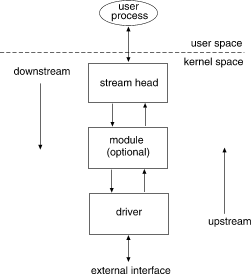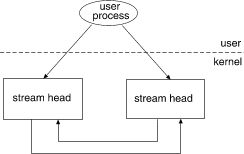
|
|
SCO OpenServer applications can do all I/O by reading or writing files, because all I/O devices, even a user's terminal, are files in the file system. Each peripheral device has an entry in the file system hierarchy, so that device names have the same structure as filenames, and the same protection mechanisms apply to devices as to files. Using the same I/O calls on a terminal as on any file makes it easy to redirect the input and output of commands from the terminal to another file. Besides the traditionally available devices, names exist for disk devices regarded as physical units outside the file system, and for absolutely addressed memory.
STREAMS is a general, flexible facility and a set of tools for development of SCO OpenServer communication services. It supports the implementation of services ranging from complete networking protocol suites to individual device drivers. STREAMS defines standard interfaces for character input/output within the kernel, and between the kernel and the rest of SCO OpenServer. The associated mechanism is simple and open-ended. It consists of a set of system calls, kernel resources, and kernel routines.
The standard interface and mechanism enable modular, portable development and easy integration of high-performance network services and their components. STREAMS does not impose any specific network architecture. The STREAMS user interface is upwardly compatible with the character I/O user level functions such as open, close, read, write, and ioctl. Benefits of STREAMS are discussed in more detail later in this section.
A ``Stream'' is a full-duplex processing and data transfer path between a STREAMS driver in kernel space and a process in user space.

Simple Streams
In the kernel, a Stream is constructed by linking a Stream head, a driver, and zero or more modules between the Stream head and driver. The ``Stream head'' is the end of the Stream nearest to the user process. All system calls made by a user level process on a Stream are processed by the Stream head.
Pipes are also STREAMS-based. A STREAMS-based pipe is a full-duplex (bidirectional) data transfer path in the kernel. It implements a connection between the kernel and one or more user processes and also shares properties of STREAMS-based devices.

STREAMS-based pipe
A STREAMS driver may be a device driver that provides the services of an external I/O device, or a software driver, commonly referred to as a pseudo-device driver. The driver typically handles data transfer between the kernel and the device and does little or no processing of data other than conversion between data structures used by the STREAMS mechanism and data structures that the device understands.
A STREAMS module represents processing functions to be performed on data flowing on the Stream. The module is a defined set of kernel-level routines and data structures used to process data, status, and control information. Data processing may involve changing the way the data is represented, adding/deleting header and trailer information to data, and/or packetizing/depacketizing data. Status and control information includes signals and input/output control information.
Each module is self-contained and functionally isolated from any other component in the Stream except its two neighboring components. The module communicates with its neighbors by passing messages. The module is not a required component in STREAMS, whereas the driver is, except in a STREAMS-based pipe where only the Stream head is required.
One or more modules may be inserted into a Stream between the Stream head and driver to perform intermediate processing of messages as they pass between the Stream head and driver. STREAMS modules are dynamically interconnected in a Stream by a user process. No kernel programming, assembly, or link editing is required to create the interconnection.
STREAMS uses queue structures to keep information about given instances of a pushed module or opened STREAMS device. A queue is a data structure that contains status information, a pointer to routines for processing messages, and pointers for administering the Stream. Queues are always allocated in pairs; one queue for the read-side and the other for the write-side. There is one queue pair for each driver and module, and the Stream head. The pair of queues is allocated whenever the Stream is opened or the module is pushed (added) onto the Stream.
Data is passed between a driver and the Stream head and between modules in the form of messages. A message is a set of data structures used to pass data, status, and control information between user processes, modules, and drivers. Messages that are passed from the Stream head toward the driver or from the process to the device, are said to travel downstream (also called write-side). Similarly, messages passed in the other direction, from the device to the process or from the driver to the Stream head, travel upstream (also called read-side).
A STREAMS message is made up of one or more message blocks. Each block consists of a header, a data block, and a data buffer. The Stream head transfers data between the data space of a user process and STREAMS kernel data space. Data to be sent to a driver from a user process is packaged into STREAMS messages and passed downstream. When a message containing data arrives at the Stream head from downstream, the message is processed by the Stream head, which copies the data into user buffers.
Within a Stream, messages are distinguished by a type indicator. Certain message types sent upstream may cause the Stream head to perform specific actions, such as sending a signal to a user process. Other message types are intended to carry information within a Stream and are not directly seen by a user process.
The provision for locking files, or portions of files, is primarily used to prevent the sort of error that can occur when two or more users of a file try to update information at the same time. The classic example is the airlines reservation system where two ticket agents each assign a passenger to Seat A, Row 5 on the 5 o'clock flight to Detroit. A locking mechanism is designed to prevent such mishaps by blocking Agent B from even seeing the seat assignment file until Agent A's transaction is complete.
File locking and record locking are really the same thing, except that file locking implies the whole file is affected; record locking means that only a specified portion of the file is locked. (Remember, in SCO OpenServer, file structure is undefined; a record is a concept of the programs that use the file.)
Two types of locks are available: read locks and write locks. If a process places a read lock on a file, other processes can also read the file but all are prevented from writing to it, that is, changing any of the data. If a process places a write lock on a file, no other processes can read or write in the file until the lock is removed. Write locks are also known as exclusive locks. The term shared lock is sometimes applied to read locks.
Another distinction needs to be made between mandatory and advisory locking. Mandatory locking means that the discipline is enforced automatically for the system calls that read, write, or create files. This is done through a permission flag established by the file's owner (or the superuser). Advisory locking means that the processes that use the file take the responsibility for setting and removing locks as needed. Thus, mandatory may sound like a simpler and better deal, but it is not so. The mandatory locking capability is included in the system to comply with an agreement with /usr/group, an organization that represents the interests of SCO OpenServer users. The principal weakness in the mandatory method is that the lock is in place only while the single system call is being made. It is extremely common for a single transaction to require a series of reads and writes before it can be considered complete. In cases like this, the term atomic is used to describe a transaction that must be viewed as an indivisible unit. The preferred way to manage locking in such a circumstance is to make certain the lock is in place before any I/O starts, and that it is not removed until the transaction is done. That calls for locking of the advisory variety.
See ``File and device input/output'' for a discussion of file and device I/O including file and record locking in detail with a number of examples. There is an example of file and record locking in the sample application in ``System calls and libraries''. The manual pages that specifically address file and record locking are fcntl(S), lockf(S), chmod(S), and fcntl(M). fcntl(S) describes the system call for file and record locking (although it is not limited to that only). fcntl(M) tells you the file control options. The subroutine lockf(S) can also be used to lock sections of a file or an entire file. Setting chmod so that all portions of a file are locked will ensure that parts of files are not corrupted.